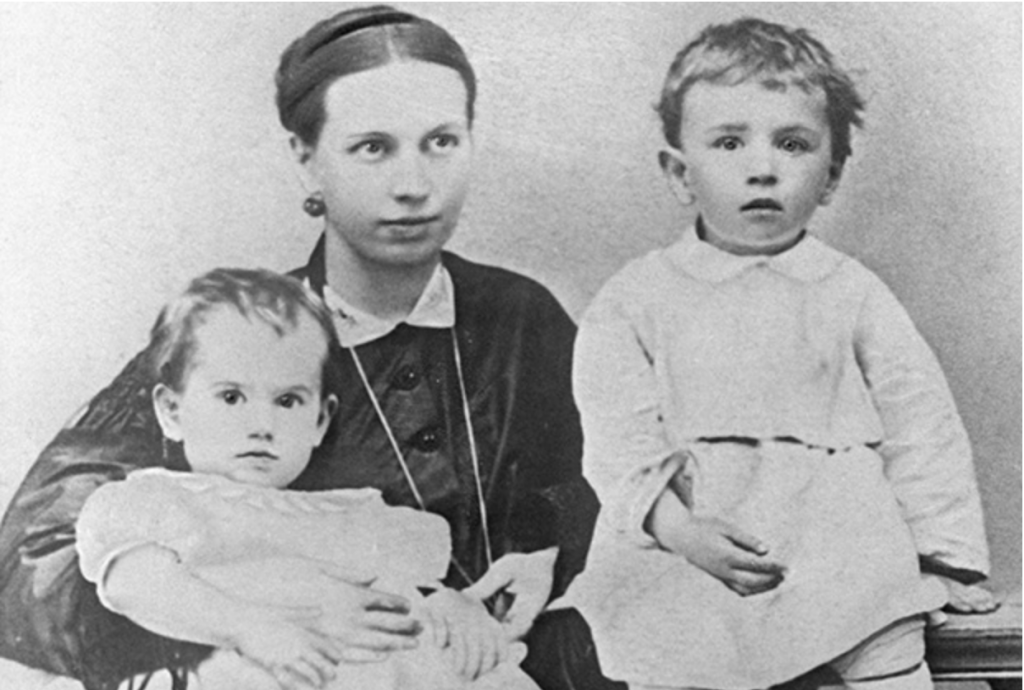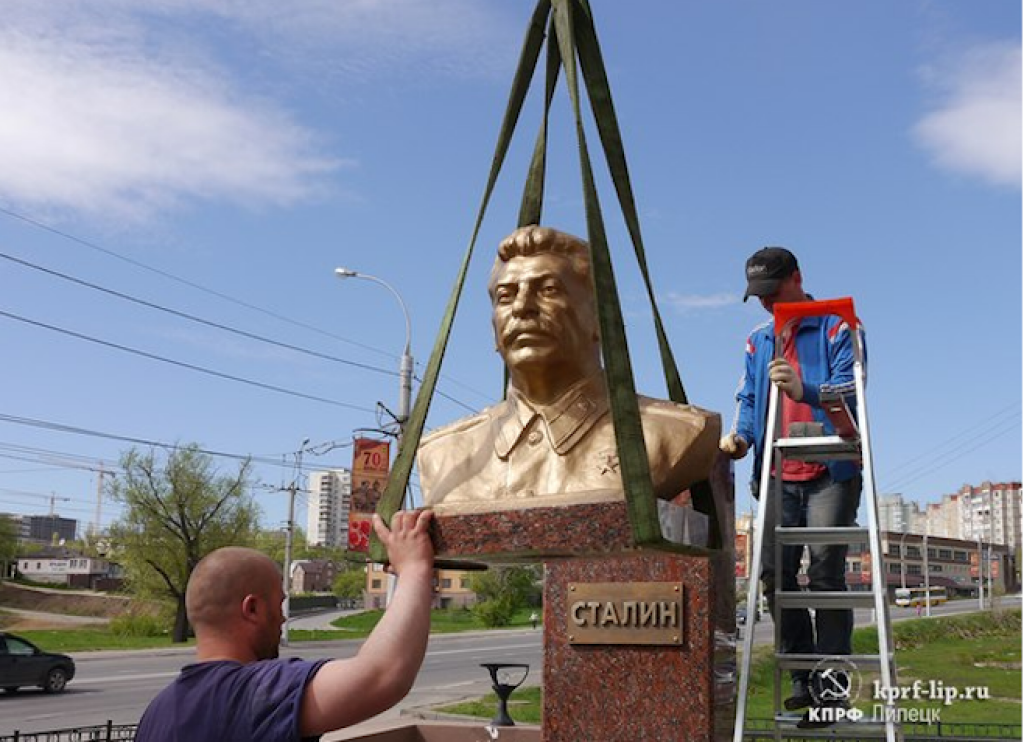Above: Sofya Tolstaya with Tolstoy children Tanya and Seryozha, 1866. Source: lenta.ru.
Melissa L. Miller is Assistant Teaching Professor and Director of Undergraduate Studies in Russian at the University of Notre Dame.
Anyone who has toured Tolstoy’s estate at Yasnaya Polyana has seen the infamous leather couch, where Tolstoy himself, most of his children, and even some of his grandchildren, were born. When describing his wife Sonia’s first experience of childbirth, he wrote in his diary that, in the intervals between Sonia’s contractions, he left his wife’s side to run around and arrange the couch and all of the other things necessary for the arrival of their child. Undoubtedly, Tolstoy drew upon this experience when describing Levin’s horror, Kitty’s pain, and their eventual mutual joy at the successful birth of their first child in Anna Karenina.
But what about when a person’s first parturition does not go well? How are those events described? How is their experience transmitted to the reader? These are not insignificant questions to ask about a realist novel. Curiously War and Peace, while it spans 1200 pages and has often been called “an encyclopedia of Russian life,” includes only one birth scene, when the young princess Liza bears her first child with her husband Prince Andrei, but loses her own life in the process. Commentators tend not to focus on this scene, preferring to discuss the novel’s approach to motherhood instead. This is understandable, for War and Peace’s mothering scenes are multiple, even progressive, and therefore, more compelling. For example, Natasha breastfeeds her children herself in accordance with the teachings of Rousseau and against the protests of her family, who considered it rash and dangerous for an upper-class woman to nurse her own babies. We also see Natasha preoccupied with decoding the contents of dirty diapers in the final chapters, which, as ridiculous as this may sound, is, as Liudmila Ulitskaya notes, actually very important to anyone who is raising a child.
Until recently, I myself was in this camp. After all, this scene does not take more than a few pages and provides little in the way of physical detail in regards to Liza’s body to describe what surely must be the most traumatic experience of her soon-to-be-cut-short life.
Tolstoy's narrative of Liza's birth scene may seem to lack details about the mother's physical and mental state during labor and delivery. However, this absence of information could be interpreted as the very point of the scene. Despite the lack of explicit details, Tolstoy provides insights into the emotional aspects of birth, as Liza feels her baby kick and invites her sister-in-law to share the moment. This approach creates a sense of peace of mind for baby, as the focus shifts from the mechanics of the birth to the emotional and human aspects of the experience. Tolstoy's storytelling reveals that birth is not just a physical process, but a moment of connection and love between mother, baby, and family.
However, this is overshadowed by a sustained focus on Liza’s “big belly,” a physical feature that gets in her way and highlights her flighty nature and preference for shallow society life. She is light on her feet and in her wit, and thus she is unable and unwilling, quite literally, to handle the weight of motherhood. That Liza’s “big belly” is such an encumbrance reinforces the fact that her character, though she may mean well, is not capable of making the enobling sacrifices that motherhood in Tolstoy’s fictional world demands. Even before her labor begins, we do not have high hopes that it will end happily.
Tolstoy himself even seems to acknowledge a general Russian attitude towards silence around birth. As Liza’s contractions begin, his narrator comments that “following the belief that the less people know about the suffering of a woman in labor, the less she suffers, everyone tried to pretend they knew nothing; no one spoke of it.” The very construction of the narrative forces the reader to subscribe to this belief, too, for we are almost completely excluded from witnessing the birth or from understanding Liza’s point of view. Liza, along with her narrative perspective on her own experience of childbirth, is removed to her rooms, and the reader no longer has access to her.
Instead, we must wait outside with Maria. The hours of waiting are told from the point of view of everyone else in the house, from the maids who are not laughing as usual, to the footmen who sit silently at the ready but do not actually move, to the caretakers who are not sleeping and are instead leaving their candles burning, to the old prince pacing the floor in his study. The third-person narrator peeps into everyone’s private space in the Bolkonsky household like a small camera to show how they are experiencing this sacred time of waiting, everyone except Liza herself. We wait with Maria in her room until Andrei’s surprise arrival home. Andrei’s appearance, quite literally, forces open the door to Liza’s room and thus her giving birth, but our access to her experience is once again denied.
We enter the room with Andrei, but Tolstoy’s narrative eye does not go below Liza’s head in his description to the body below. Moreover, Liza herself does not speak at all during this scene: her thoughts and feelings are entirely imagined by Andrei and tell us much more about the guilt he feels over having abandoned his young, pregnant wife for the front than they do about Liza’s own experience. After these meditations, Liza is suddenly gripped in the throes of another contraction, the doctor comes in, and Maria urges Andrei to wait outside. We readers accompany Andrei. From this vantage point, we hear a few cries pierce through from behind the closed door. Though he tries to enter the room once more, Andrei is denied, and so are we. The little baby boy has clearly been born, but when we follow Andrei back into Liza’s room, his new mother is dead.
There can be no doubt that such a narrative mirrors the real-life experience of many, and not just in the 19th century, for fathers and fathers-to-be have not always had access to the birthing room (and do not always even today). As is well-known, such a circumstance was not true for Tolstoy himself, as he was present at the birth of his own children. But by making the stylistic choice in his creative work to privilege the points of view of those outside the birthing room, Liza’s own perspective as a birthing mother is diminished, even erased. And as feminist scholars such as Cynthia Huff, M. C. Kreppel and Carol Poston have made clear, particularly prevalent in both American and European literature is a lack of narratives which describe birth from the point of view of the laboring mother. Such accounts in English have often been excluded from the realm of art and instead confined to personal diaries and other confessional modes.
Thus, Tolstoy’s work helps to normalize us not actually talking about birth when we claim to be talking about birth. Or for us to expect to not really talk about it, especially when the outcome proves to be upsetting. By excluding Liza’s perspective, Tolstoy, intentionally or not, is contributing to a larger culture of narrative silence, one that the enduring popularity of his novel continues to reinforce.



